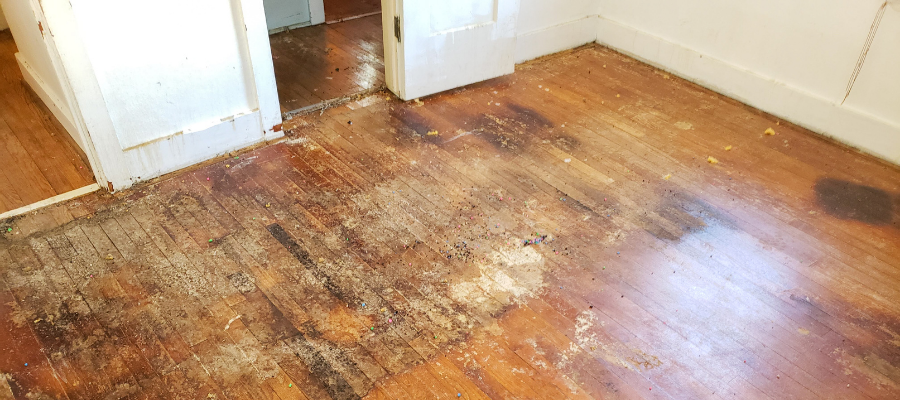Water damage is an unsightly scene – one that homeowners hope they never have to encounter. Whether the damage was caused by something minor such as an overlooked spill or a leaking window or door, or an incident more serious such as a collapsed roof or flooding, it is a serious matter and needs to be tended to as quickly as possible.
Water damage is quite literally when water damages your hardwood floors. When left unattended, water absorbs through the wood’s pores, causing it to swell, warp and discolor. This can lead to further damage by rotting the wood and growing bacteria and mold, which is a health hazard to you and your family. Wood in this condition needs to be replaced immediately.
You can help protect your floors against water damage in a number of ways. By cleaning the spill up quickly, you can ensure that the water doesn’t sit on the wood’s surface too long. You can also apply a layer of protective coating to your wood floors to help prevent the water from being absorbed into the wood. If your wood floors are old or in high-traffic areas, they are apt to experience more wear and tear and may need the protective coating reapplied. Be sure to check your doors and windows for signs of a leak, before damage gets too serious. Should water enter your home and pose a risk for serious damage, hand dry the floors as much as possible and utilize a dehumidifier to help pull the moisture out of the floors and the space.
So, how do you know when your home is suffering from water damage? Here are a few tell-tale signs that your hardwood floors have been exposed to water and are damaged:
The floors are warped and misshaped. As water absorbs into the pores of the wood, it causes the wood to expand and become warped. This can be easy to spot as the surface of your floor will feel and look bumpy and uneven.
You notice discoloration of the wood. Water damage also affects the look of your hardwood floors. If you see spots and patches of staining and dark coloration, it is most likely caused by water damage. Discoloration and warping typically go hand-in-hand. You’ll notice areas that are warped and misshaped to be the areas with the most discoloration.
Floorboards or nails are starting to lift. Much like warping, if the water damage is great enough, the swelling will cause nails to lift out of the wood. This is extremely hazardous, especially in high-traffic areas. In even worse cases, the floorboards themselves will begin to lift out of the floor. Noticing lifted nails and floorboards should be a strong indicator of water damage.
Mold is starting to grow and releases odors. If left untreated for an extensive period of time, water damage can cause mold to grow on the affected area(s) of wood. While sometimes this can easily be overlooked, it can be recognized by its smell. If you start to smell new odors in your home that are musty or resemble mildew, it could be mold.
Water damage is an unfortunate, yet common problem. It is fixable, but can be costly. If the damage cannot be fixed with a dehumidifier, it may have to be replaced altogether. Consult with a hardwood professional to see how you can best, and more economically, fix your water damage.
Hardwood Flooring Services in Charlotte, NC
Here at Zack Hardwood Flooring, we offer a full range of hardwood flooring services to residential homes and commercial facilities, here are our main hardwood services:
- Hardwood Flooring Installation
- Hardwood Flooring Refinishing
- Hardwood Stair Remodeling
- Hardwood Floor Sanding
- Hardwood Floor Staining
Are you ready to get your hardwood floor installed properly and professionally? Contact Zack Hardwood Flooring today, or call us at 704-899-5222

